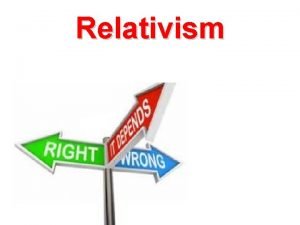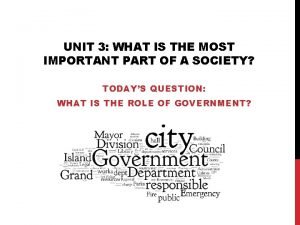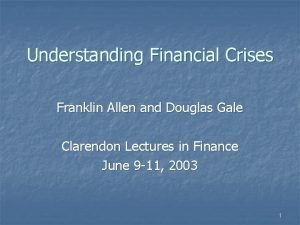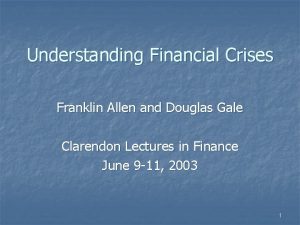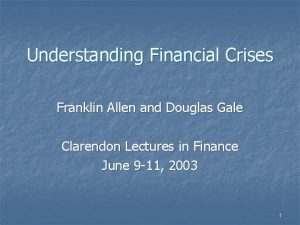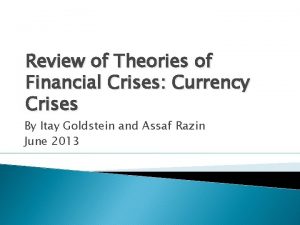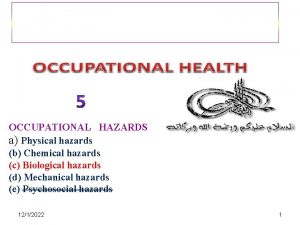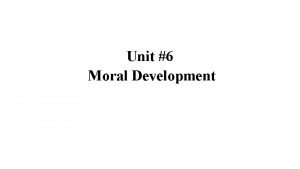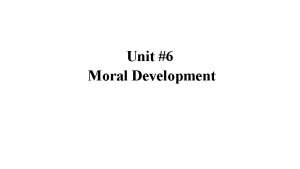Governments Moral Hazards and Financial Crises Franklin Allen


















- Slides: 18

Governments, Moral Hazards, and Financial Crises Franklin Allen Wharton School University of Pennsylvania Norges Bank Conference September 1 -2, 2010

What caused the crisis? • The large global impact of the crisis suggests that the problems with subprime mortgages were a symptom rather than the cause • The main problem is that there was a bubble in property prices in the U. S. , Spain, Ireland elsewhere, and the bursting of this bubble started the crisis • Subprime mortgages were the first place that the crisis hit • Spain illustrates there would have been a problem even without subprime 2

Current Crisis: Case-Shiller 10 Cities Composite Source=S&P 3

Percentage Change in Case-Shiller 10 Cities Composite Source=S&P 4

What caused the bubble? • The monetary policies of central banks particularly the U. S. Federal Reserve and ECB in some countries were too loose – they focused too much on consumer price inflation and ignored asset price inflation • Global imbalances – the Asian crisis of 1997 and the policies of the IMF led to a desire among Asian governments to save funds 5

Reserves: A Comparison 6

Subsequent developments • The bursting of the bubble caused the initial problems in the crisis but this was then followed by a severe episode of contagion after the Lehman default in 2008 • This year we have seen the next stage of the problem which is the sovereign debt crisis in Europe • What role did moral hazard play in these various stages of the crisis? 7

Different types of moral hazard I. Traditional moral hazard II. “Too-big-to-fail” moral hazard III. Public sector moral hazard IV. Sovereign debt moral hazard 8

I. Traditional moral hazard • Crises due to panics rather than fundamentals • Need deposit insurance to prevent panics • Moral hazard problem because of deposit insurance • Regulation needed to prevent risk taking of this type • How important in the current crisis – RBS/Fortis takeover of ABN Amro? 9

II. “Too-big-to-fail” moral hazard • Large banks know they will be saved because otherwise there will be contagion and this encourages them to take risks • Current crisis has reinforced this view particularly in the U. S. • How should this problem be solved? 10

Systemically important financial institutions • “Too-big-to-fail” is not “Too-big-to-liquidate” • The government needs to guarantee the short term commitments of failing banks to prevent contagion • When a bank fails or is close to failure the government should step in, take it over and resolve it – the top 5 executives should be removed immediately – all employee pension claims should be eliminated – over the next few years the bank should be liquidated • International issues 11

Resolving large cross-border financial institutions • Eliminate cross-border branches and require subsidiaries • Regulators should monitor the degree of mismatch between assets and liabilities within the country with significant mismatches leading to posting of collateral • Large equity buffers of 20 percent in terms of accounting and market capital • Banks resolved when equity falls below 5 percent 12

III. Public sector moral hazard • Most central banks are designed for crisis management rather than crisis prevention – they are hierarchical and dissension is discouraged • During the current crisis central banks did a good job of crisis management but a very poor job of crisis prevention • Arguably they were one of the main causes of the real estate bubbles that started the crisis by setting too low rates given that real estate prices are positively serially correlated and there were already booms under way 13

Reform of central banks • Institutional structure needs to be changed so they do a better job of crisis prevention • The private sector is being criticized for taking so much risk but the Federal Reserve, ECB and other central banks took large risks, e. g. not just low interest rates but currently quantitative easing • There needs to be some mechanism of checks and balances such as a Financial Stability Board that helps to control public sector moral hazard 14

Global imbalances • Another form of public sector moral hazard • Self-insurance by Asian countries through large reserves is optimal for them, e. g. South Korea • However, it is a very inefficient mechanism from a global perspective • Reform of the IMF? • Regional risk sharing • Bilateral swaps to give foreign exchange safety net 15

IV. Sovereign debt moral hazard • Similarly to the “Too-big-to-fail” problem with banks there is also a problem with sovereign debt • Sovereign default is likely to lead to contagion and this provides an incentive for other countries to bail out any country in trouble • But this creates a large moral hazard for countries to be profligate and Greece is a good example of this 16

A bankruptcy mechanism for the Eurozone • Mechanism should be designed to allow default without a bailout • When the country defaults it is allowed to issue debt that is senior to defaulted claims so that it can support its banking system similarly to debtor-in-possession financing • Team from ECB/Commission decides how much the debt will be written down so that the recovery path is sustainable - if the country disagrees it must exit the Eurozone 17

Concluding remarks • There are many kinds of moral hazard not just moral hazards from deposit insurance and too-big-to-fail • Central banks and governments are also subject to moral hazards – they do not just arise in the private sector • We need to devise ways of dealing with all of these moral hazard problems 18
 The crises
The crises Mouse meervoud
Mouse meervoud Ein gleiches analyse
Ein gleiches analyse Solaris bank
Solaris bank Moral realism
Moral realism Moral relativism
Moral relativism Moral individu dan moral kelompok
Moral individu dan moral kelompok Moral de esclavos y moral de señores
Moral de esclavos y moral de señores Why do people create, structure, and change government?
Why do people create, structure, and change government? How do the governments of kenya and nigeria compare?
How do the governments of kenya and nigeria compare? Unlimited governments
Unlimited governments Financial and non financial methods of motivation
Financial and non financial methods of motivation Herbert hoover and franklin roosevelt compare and contrast
Herbert hoover and franklin roosevelt compare and contrast Different kind of governments
Different kind of governments Two effects of allied bombing raids on japan
Two effects of allied bombing raids on japan Se asia governments comprehension check
Se asia governments comprehension check Comparing se asian governments
Comparing se asian governments Is japan a unitary state
Is japan a unitary state Comparing asian governments
Comparing asian governments





